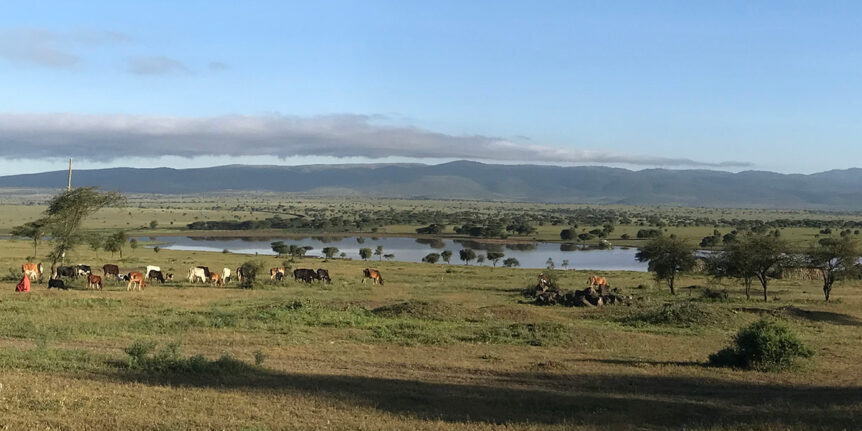Blog post by Pierre Ellssel (BOKU, Vienna)
In the heart of Berlin at the renowned Humboldt University, we had the privilege of participating in the Annual Interdisciplinary Conference on Research in Tropical and Subtropical Agriculture, Natural Resource Management, and Rural Development, known as Tropentag. This year’s conference theme, “Competing pathways for equitable food systems transformation: trade-offs and synergies,” brought together experts and researchers from around the world to share their insights on the pressing issues of our time. Our oral presentation, titled “From waste to wonder? Scaling the off-farm production of organic and biofertilizers in Africa: A scoping study,” explored a vital aspect of sustainable agriculture, circular economy and food security.

African Agriculture: Facing Various Challenges
Agricultural productivity in Africa, particularly in sub-Saharan Africa (SSA), has long been a matter of concern. It ranks among the lowest in the world, while land and resource degradation are rampant in many regions. The COVID-19 pandemic and the war of Russia against Ukraine has further aggravated the situation. These crises disrupted supply chains, energy markets, and led to export restrictions and sharply increasing prices, causing food and agricultural input shortages, especially inorganic fertilizers.
Smallholder farmers in Africa, who are the backbone of agricultural production, have been hit particularly hard. They produce 70% to 80% of the continent’s agricultural output. However, the use of inorganic fertilizers among smallholders has always been limited due to various factors such as inadequate transportation and distribution systems, high costs, and import dependence. Even where they are used, issues like low soil organic matter content and soil acidity often hinder their effectiveness.
The Search for Sustainable Solutions
To address this critical issue and improve food security in Africa, innovative solutions are needed. While increasing the production and use of inorganic fertilizers can be part of the solution, it cannot be the sole answer, considering the challenges. One promising approach is to scale up both the on-farm and off-farm production of organic and biofertilizers.
Organic and biofertilizers (biostimulants) offer the potential to support soil health and fertility, addressing soil degradation issues while increasing self-sufficiency in nutrient production and crop productivity. These products provide diverse trace elements, enhance organic matter in the soil, boost nutrient availability, and specifically in the case of biofertilizers can improve plant health and vitality.
Understanding the Challenge
In response to this complex problem, our team embarked on a scoping study aimed at better understanding the opportunities and challenges involved in scaling up the off-farm production of organic (OF) and biofertilizers (BF) in Africa. The study involved a broad range of research questions and objectives:
- Describing the current state of production and technology, including the origin of organic matter, quantities produced, and market prices.
- Assessing the current demand for and usage of organic and biofertilizers.
- Identifying the potential supply of nutrients and organic matter from organic waste streams.
- Analysing the policy landscape and regulatory environment related to organic and biofertilizers.
A Multifaceted Approach
To achieve these objectives, we employed a mixed-methods approach. This approach combined a thorough literature review with 89 qualitative interviews involving key informants from various sub-regions across Africa. Our interviewees included a diverse array of stakeholders, such as producers, researchers, farmer organizations, advisory services, policy makers, and farmers themselves.
Unlocking Potential: From Waste to Fertiliser
Our research uncovered a promising landscape of activities and business models in which entrepreneurs are recycling residues from agro-processing wastes into soil amendments such as compost and organic fertilisers. These activities include the conversion of municipal organic and human waste, crop production residues, animal manure, and the occasional mixing of these materials with inorganic fertilisers or biochar. Additionally, we found instances of liquid fertilisers being produced from human urine. We found various technologies for organic waste conversion spanning from manual and highly mechanized composting operations to other innovative methods such as utilizing Black Soldier Flies, vermi-composting, and composting techniques within semi-closed container systems.
Yet, the quantities of organic fertilisers currently being produced remain relatively small, while the demand for sustainable alternatives is on the rise. Prices for these alternative fertilisers exhibit significant variation. In the case of biofertilizers, some success stories exist for rhizobia production and application. However, for other biofertilizer types, as well as organic fertilisers, verifiable results regarding product efficacy in the local contexts are often lacking as well as product solutions adapted to specific crop and soil types.
Untapped Potential and Key Challenges
Our study also identified significant untapped potential in urban and value chain waste streams. To fully harness this potential, several critical factors need to be addressed, including:
- Recycling and reuse policies (e.g., collection systems based on source separation).
- Policy coherence between different sectors (sanitation, waste, and agriculture).
- Quality enforcement and adherence to governmental regulations (where existent).
- Cross-sector collaboration between sanitation, waste, and agriculture.
- Technical assistance and support.
- Integration into education, training, and research.
- Evidence and capacity building.
- Market incentives and an improved business environment.
Diverse Strategies for Soil Health
To achieve soil health and enhanced agricultural production, it’s essential to adopt a holistic approach. Alongside organic and biofertilizers, farmers should diversify their cropping systems, integrate legumes, practice soil cover, reduce tillage, recycle on-farm organic fertilizers, implement agroforestry and alley cropping, and ensure the use of quality seeds and efficient water supply systems.
A Collaborative Effort
In conclusion, our findings stress the need for a concerted and coordinated effort by both the private and public sectors, as well as farmer organizations. Working together, we can establish a robust and sustainable off-farm production ecosystem for organic and biofertilizers in Africa. Our scoping study serves as a valuable resource for policymakers, entrepreneurs, researchers, and all stakeholders along the fertiliser value chains. By adopting our policy recommendations, we can promote sustainable agricultural practices and contribute to equitable food systems transformation.
As we reflect on our participation in Tropentag 2023, we are optimistic about the potential for change and innovation in the field of agriculture. By scaling the off-farm production of organic and biofertilizers in Africa, we can contribute to a more resilient and sustainable food system that addresses the challenges of our time.
by Pierre Ellssel (BOKU, Vienna)

